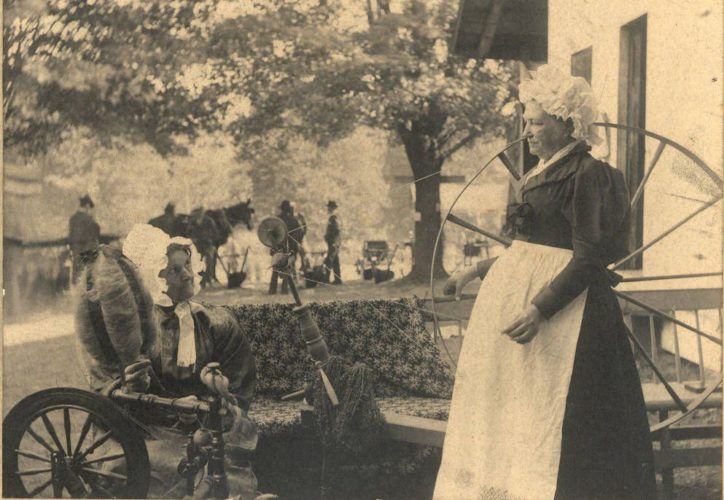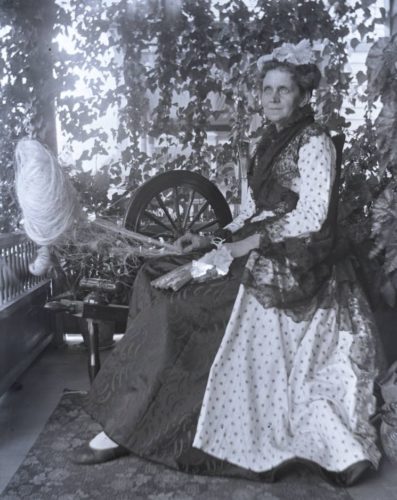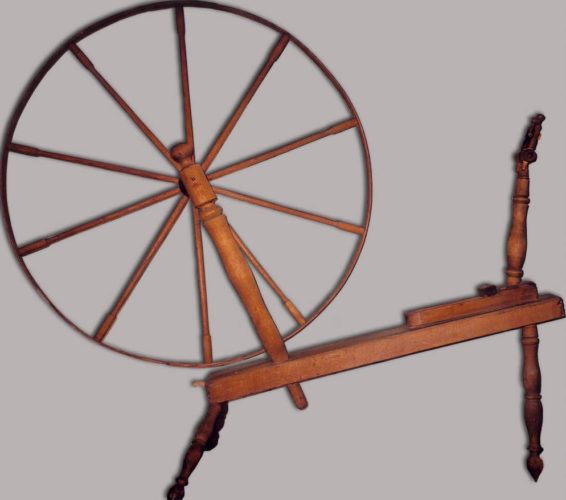Spinning Dreams of Long, Long Ago: Spindles and Spinning Wheels

Long before the advent of written history, humans were using sticks to spin fibers together into long strands, which could then be twisted into rope or knitted or woven into cloth or net. Flax, wool, cotton, or other materials were secured to the stick, and the stick was sent spinning while dangling from the spinner’s hand. Fiber was then fed out of the hand, where it picked up twist and joined in building threads for weaving or knitting.

As technology advanced, so did the tools used for spinning, but their function remained the same: each added twist to raw fiber in order to produce strong, continuous thread. Ohio Memory has images of a number of the tools that have been used in spinning, tools similar to what is on the market today. One such example is the drop spindle. Drop spindles are the oldest tool used for spinning, and are made with some sort of stick – the shaft – and a weight, or whorl, which aids in the continuous spinning necessary for twist. Drop spindles may have the whorl at the top or the bottom, and they may also have a hook at the top to help hold the fiber in place. This drop spindle, from Zoar, is likely bottom-whorl; the yarn, which is still wound on the spindle, would have been spun from the top with the whorl at the bottom. Due to their portability, drop spindles continue to be popular with spinners today, who sometimes say that wheels may be faster by the day, but spindles are faster by the year. In other words, one can spin fiber more quickly while sitting at a wheel, but the wheel can only be used while sitting, while some spinners use their spindles while walking, riding in the car… just about anywhere!
Drop spindles are a good choice for fibers that tend to be sturdy and to grab onto themselves, such as wool. For more slippery fibers – silk, for instance, or plant fibers – a supported spindle is often a better tool; this example, also from Zoar, shows a spindle that is supported by a small tray. Fiber was attached to a leader – a scrap piece of yarn – at the top, with the rest of the fiber supply being held by the spinner. The leader would twist, grabbing and twisting the new fiber as it was drafted out, spinning the new fiber into yarn or thread. This is a similar method as the drop spindle, with the difference being that drop spindles literally “drop” from the spinner’s hand and are dependent upon the fiber holding them aloft, while supported spindles don’t drop and, thus, don’t require the same grabbing characteristic in the fiber that drop spindles do.
Most likely, when you think of spinning, it is the wheel that comes to mind. Spinning wheels are a newer invention, most likely dating to 500-1000 C.E. and originating in Asia. According to Early American Life magazine (June 2009), “Sometime between 500 and 1,000 A.D., probably in India, someone turned a spindle on its side and shaped the weight or whorl into a pulley and connected it by a band to a drive wheel.” Indeed, all spinning wheels require these three components: a spindle and drive wheel which are joined by a pulley. From there, however, designs and options vary.

The walking wheel, also known as a great wheel, was designed for spinning wool, either for weaving or for knitting. The wheel at left, from the Centerville-Washington Township Historical Society, is missing its drive band, but imagine that a strap of cord, leather or yarn runs around the wheel and connects to the spindle, which is located, in this picture, on the right-hand side. Walking wheels are large – generally at least 5 feet tall – and operators stand, rather than sit, when spinning. As with earlier spinning tools, fiber is loaded onto the spindle via a leader, with the rest of the fiber supply being held in the spinner’s hand. The wheel is turned manually, and the spinner draws back the fiber (again, typically wool) to twist and feed new fiber onto the spindle. This method of drafting, or pulling fiber out to allow it to twist, is called “long draw,” and it adds air and loft, creating a warm yarn. As needed, the spinner will walk back from the wheel as the wool is drafted out, thus the name “walking wheel.”
Flax wheels, or treadle wheels, are versatile and can be used for all spinning materials. Again, this wheel operates in the same manner as the others, using a drive wheel, pulley, and spindle. However, the drive wheel is operated via one or two foot treadles. This flax wheel from the Ohio History Connection has a single treadle, but that isn’t all that is quite different from the walking wheel. It also has a piece called a “mother of all,” which holds the spindle; a bobbin that is fitted over the spindle; a flyer that twists and then wraps spun yarn around the bobbin; and a distaff, which, in this picture, is holding unspun flax that is destined to become linen. Incidentally, Disney’s “Sleeping Beauty” says that Aurora pricked her finger on a spindle, but what she actually touches in the movie is the distaff. While the spindle tip can absolutely be sharp, the distaff is decidedly not!
The same Early American Life issue mentioned above tells us that “before the Civil War, nearly half the homes in America had a spinning wheel.” In a quote by Craig Evans, a traditional spinner and weaver, the magazine states that “Inventories of households from this period [post-Revolutionary War to the 1840s] certainly indicate the presence of both types of wheels.” Peak domestic textile production occurred during this time period, most likely due to trade embargoes that were put into place during the War of 1812.
On October 27, 1846, the Ohio State Journal ran a delightful piece on the spinning wheel and its place in the household:
In a sheltered corner, seated in a high backed armchair, sat the beloved and venerated grandmother, on whose placid countenance not a trace of human passions was visible, and before her stood an instrument of music, which, even yet, is sweeter to our rebellious ears than one of Erard’s finest harps. Its measured and monotonous cadence made an appropriate accompaniment to the conversation of the domestic circle, of which the dear musician was the very life and soul, with her wise and cheerful comments on passing events, and her varied reminiscences of the past. Do our youthful readers wish to know the name of the musical instrument to which we listened? Start not, gentle reader, it was not a harpsichord or lute, but a simple, unpretending, linen spinning wheel.
Spinning wheels, though less ubiquitous now than in the past, are still widely used by crafters who wish to play a larger role in their garment construction. Functional antique wheels are treasured by spinners, and new wheels soon become family heirlooms. Drop spindles continue to be utilized and treasured, as well, and though it is fairly unusual to see someone spinning “in the wild,” it isn’t unheard of. The next time you see someone spinning, either on a wheel or on a spindle, ask them questions about their crafts. Spinners enjoy sharing their love of spinning with others, and who knows? You might decide to give it a try yourself!
Thank you to Shannon Kupfer, Digital Initiatives Librarian at theState Library of Ohio, for this week’s post!



Leave a Reply
You must be logged in to post a comment.